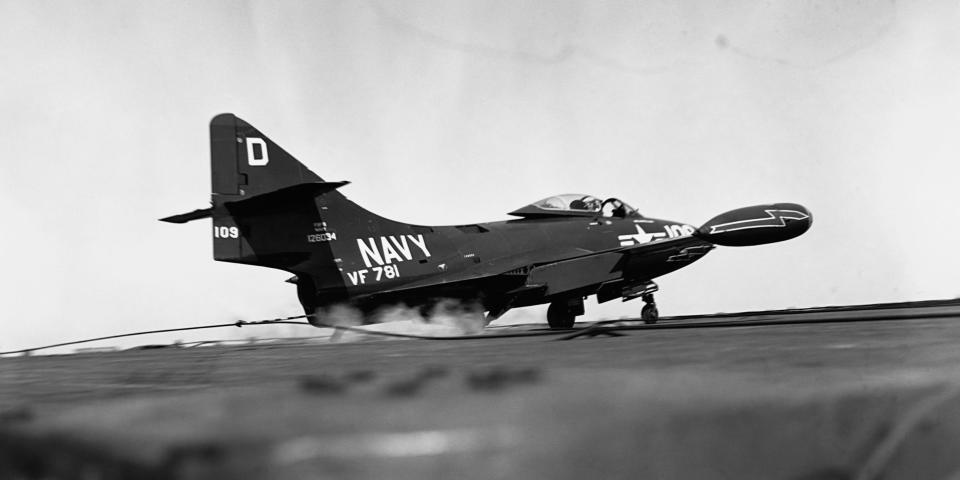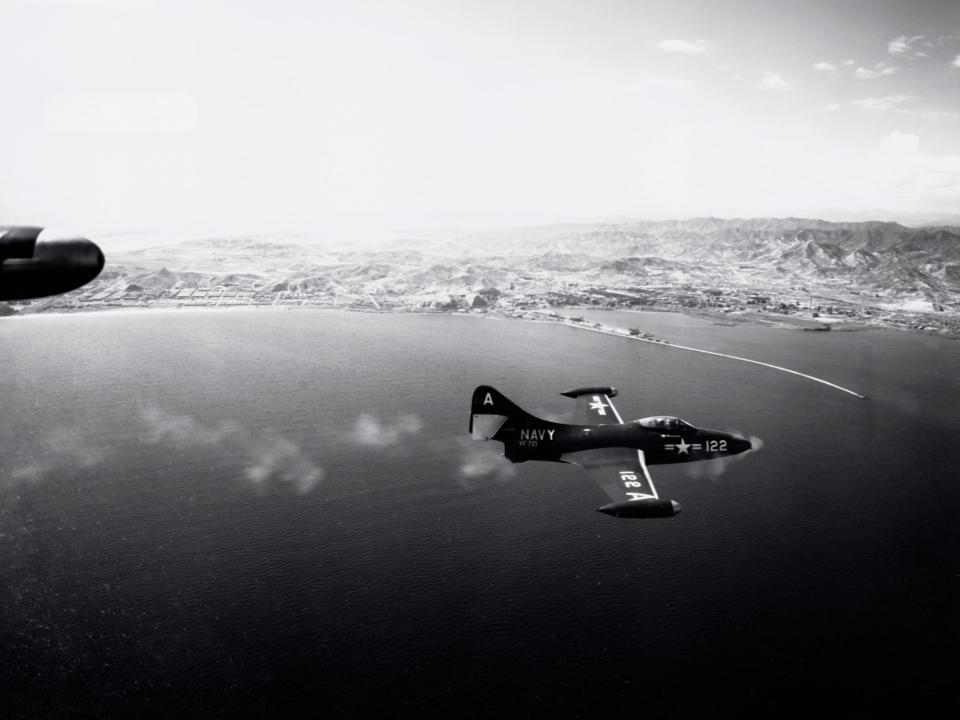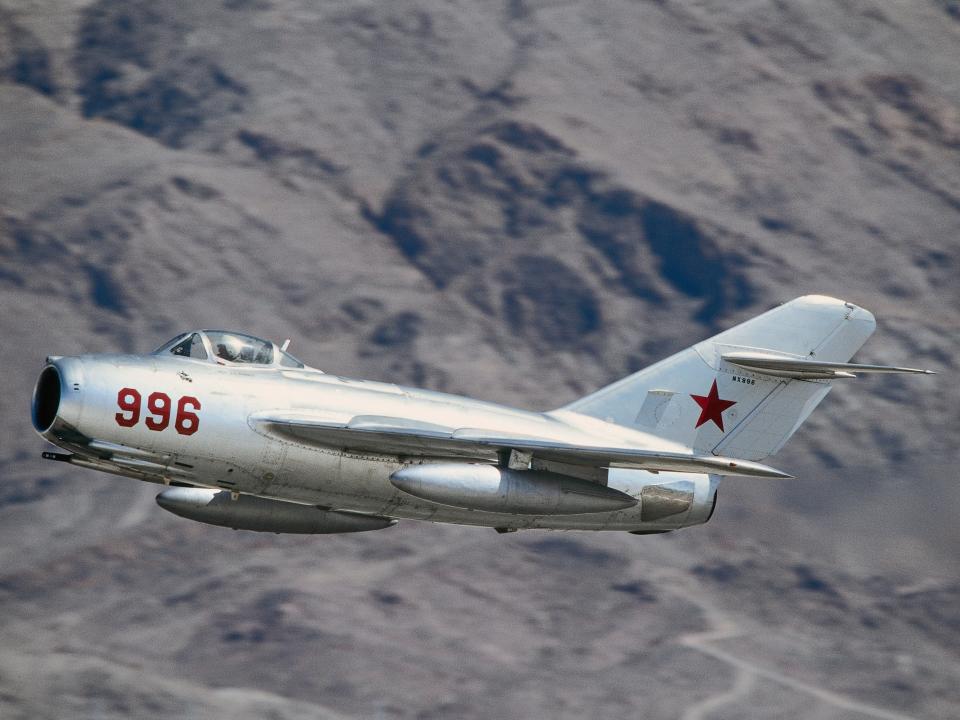Here's how a wildly outgunned US Navy pilot outfoxed one of the Soviet Union's best jets, scoring a string of kills in a legendary dogfight

An outgunned US Navy pilot downed four Soviet MiG-15 jets in a legendary dogfight over 70 years ago.
Royce Williams was flying an inferior F9F Panther.
Military aviation experts say Williams' success that day was a result of his training and readiness.
More than 70 years ago, a US Navy pilot took on seven Soviet aircraft — then among the world's best interceptor fighters — and shot down four of them in a legendary dogfight that was classified for decades.
The Korean War air battle is no longer a secret, and the pilot, Royce Williams, was recently awarded the Navy Cross for his display of "extraordinary heroism."
Williams was outmatched that day, fighting in an inferior plane with the numbers clearly on the enemy's side. Insider asked naval-aviation experts how he pulled off a win with the odds stacked against him. They said it was his training and readiness that saw him through that.
On November 18, 1952, the day of the battle, Williams was flying an F9F Panther, a Navy carrier-based jet fighter, as part of a team of three planes from the fighter squadron VF-781 during a combat-patrol mission over the Sea of Japan when they encountered seven Mikoyan-Gurevich MiG-15 jet fighters. This swept-wing Soviet aircraft was considered to be superior to the straight-wing American Panther in terms of overall performance.
The Soviet jets engaged the American team, and it wasn't long before Williams found himself fighting alone. An unexpected fuel-pump issue forced the team's flight leader to return to the aircraft carrier Oriskany, leaving just the young lieutenant and his wingman. Then when Williams shot down one of the enemy planes, his wingman pursued it, and Williams was left to take on the six remaining Soviet aircraft on his own.
Williams was outgunned and outnumbered as he took on the Soviet jets in what became the longest dogfight in US military history, but he held his own. According to Pacific Fleet, during the 35-minute battle, he shot down four MiG-15s in a single fight, something no American pilot had ever done. But as the US and Soviet Union were not engaged in open conflict, his exploits were kept secret.
According to Williams' Navy Cross citation, his plane was "severely damaged" by a direct hit from one of the Soviet MiG-15s, but he continued to engage the Soviets until he managed to escape through the clouds and land a "nearly uncontrollable" plane back on the USS Oriskany.

'The only thing I could do was out-turn them'
Manufactured by Grumman, the F9F Panther first flew in 1947 and became the backbone of US Navy and Marine Corps air fleets during the Korean War, according to the National Museum of the US Navy. They were armed with four 20 mm cannons and also carried air-to-ground munitions.
Hill Goodspeed, the deputy director at the National Naval Aviation Museum, told Insider that during the Korean War, the Panther primarily conducted ground strike missions as opposed to engaging in air-to-air fighting.
The MiG-15, meanwhile, first entered service in 1949 and operated against United Nations forces during the Korean War, according to the National Museum of the US Air Force. This aircraft was armed with 23 mm cannons and a 37 mm cannon.

Though the MiG-15 could fly faster and climb to a higher altitude, the Panther had the advantage in turning ability. When an aircraft is able to out-turn another, it can prevent an enemy from getting a good shot. The Panther also had certain firepower advantages with a more stable firing platform than the MiG-15, Goodspeed said.
Williams told the American Veterans Center in a 2021 video interview that the MiG-15 was the "best fighter airplane in the world" at the time and that "plane on plane," he was at a clear disadvantage.
"In the moment I was a fighter pilot doing my job," Williams said in an account of the fight, according to Pacific Fleet. "I was only shooting what I had," he recalled. "They had me cold on maneuverability and acceleration — the MiG was vastly superior on those counts to the F9F. The only thing I could do was out-turn them."
Goodspeed said human factors and the ability to understand the enemy were critical in a fight like this, explaining "it all comes down — first and foremost — to the person in the cockpit and the training they've received."

This dogfight was 'a very rare feat'
Guy Snodgrass, a career Navy fighter pilot and former US defense official, told Insider that Williams' engagement "justifies" the role of institutions like the US Navy Strike Fighter Tactics Instructor program — also known as TOPGUN. It's not always possible to change the equipment that the US has in its arsenal, but military institutions can help shape training and readiness levels.
"Having a better piece of equipment can lull you into a false sense of security that your equipment is going to take care of the engagement for you. And that's not the case," said Snodgrass, a former TOPGUN instructor. "Once you get inside that visual arena, then you're in a position where your skills, your dedication, your hard work, staying in the fight — all those things become outsized factors that can really turn the tide of the conflict."
Snodgrass said one element of the TOPGUN training was studying "adversarial" aircraft made by countries that the US might have a greater chance of going up against in the future — like Russia or China. These are then compared with the strengths and weaknesses of US aircraft.
Williams' dogfight isn't the only example of US planes battling enemy aircraft that are superior on paper. During World War II, for example, the Navy's F4F Wildcat went up against Japan's Mitsubishi A6M Zero, which was considered to be the more capable plane in part because of its maneuverability, Goodspeed said.
That said, "in the jet age, to shoot down multiple jets in air-to-air combat was a very rare feat," Goodspeed explained, comparing later fights with those during World War II, when an aviator might shoot down several planes in one day.
Snodgrass said there were lots of big-picture lessons to extract from large-scale wars like Korea or Vietnam, and specific engagements — like Williams' dogfight — demonstrate how a pilot can use their strengths in a situation where they may be outmatched.
"The machines have advanced. The tactics have advanced," the former aviator said. "So it's really more the principle that you're going after rather than the specifics of this case."

The US government classified the legendary 1952 dogfight, and Williams, who was awarded the Silver Star in May 1953 and retired from the Navy in 1980, was sworn to secrecy about what happened until his story was finally declassified about 20 years ago.
Because Secretary of the Navy Carlos Del Toro has the authority to upgrade awards, he decided to review Williams' case and said it stood out. On January 20, he presented Williams with the Navy Cross, which is the service's second-highest military honor.
"It was very clear to me that his actions were extraordinary, and more closely aligned with the criteria describing a higher award," Del Toro said of Williams during a ceremony in San Diego. "And sir, what a tremendous honor it was to tell you in person, that after all these years, your courageous actions would finally get the recognition they deserve."
Correction: February 2, 2023 —An earlier version of this article misstated the Grumman F9F Panther's place in naval aviation history. The first carrier-based jet-powered fighter was not the Panther. It was the McDonnell Aircraft Company FH-1 Phantom.
Read the original article on Business Insider

